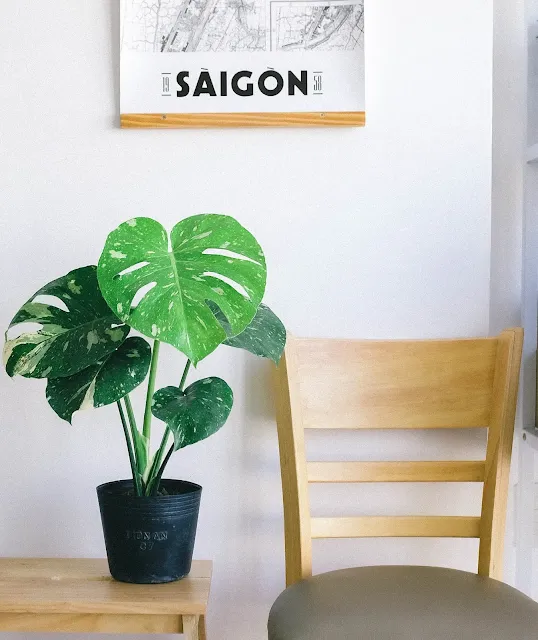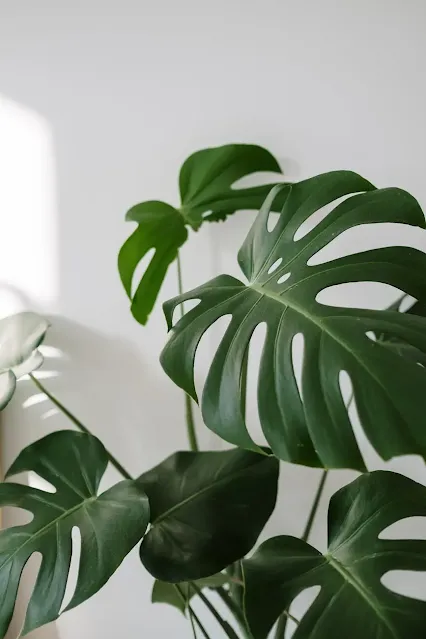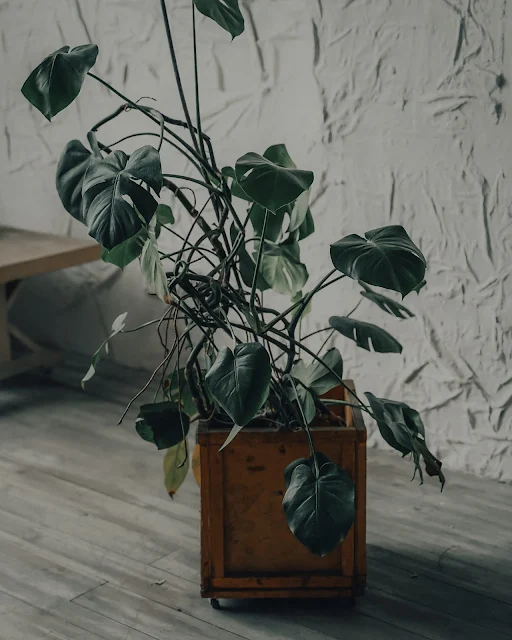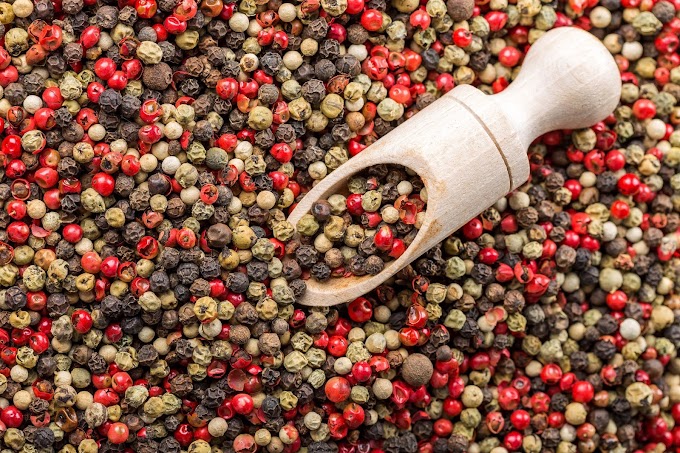 |
| How To Propagate Monstera Adansonii |
Blog last updated on December 22, 2022
How To Propagate Monstera Adansonii
Monstera adansonii is a famous houseplant that belongs to the Araceae family (flowering plants) with big leaves. Many homeowners love to add a touch of South America through this potted plant. Fortunately, this species is relatively straightforward when it comes to caring for them. No wonder, people love them and are always eager to know How To Propagate Monstera Adansonii.
With age, the leaves of Monstera adansonii become perforated which gives it a distinct appearance having large perforated heart-shaped leaves. I am not sure how and who found these perforations matching the swiss cheese but nevertheless, the plant got an additional name of swiss cheese plant or swiss
This is a tropical perennial from Central and South America that is typically grown as a houseplant. The Swiss cheese plant climbs rapidly under favorable conditions. If you give it a stake or trellis to grow upwards, it will enjoy larger leaves with those unique holes.
How To Propagate Monstera Adansonii
Botanical name: Monstera adansonii
Common names: Swiss cheese plant, Adanson's monstera, Swiss cheese vine, five-hole plant
Plant Type: Tropical Perennial Creeper
Mature size: up to 60 feet with proper support
Sun exposure: bright indirect light
Soil type: peat-based potting soil
Soil PH: 5.5 to 7. 0 (slightly acidic to neutral)
Flowering time: spring (but usually only in nature)
Flower color: purple, cream
Hardiness zones: 10 to 11
Native area: Central and South America
Related article:
WHAT IS A MONSTERA ADANSONII PLANT LIKE?
As mentioned above, this plant is mainly found in South and Central America. In nature, it tends to inhabit areas near rivers, particularly those found at lower elevations.
DOMESTIC PLANT CARE - MONSTERA ADANSONII
The most common name for this plant is "Swiss Cheese Vine". This name refers to the iconic leaves that are large, heart-shaped, and covered with holes of various sizes.
They are approximately 21 to 42 centimeters long.
 |
| How To Propagate Monstera Adansonii |
VARIETIES OF MONSTERA ADANSONII
The swiss cheese vine plant has a plethora of varieties. Specifically, the way the leaves look and the holes in the leaves vary from type to type. We have at least 4 different types of crops. Some are extremely leaky, while others have only a few holes.
Also, some grow much larger leaves than others. Some of the variants have fairly rounded leaves while others are thinner. There are two different shapes called Monstera Adansonii round shape and Monstera Adansonii narrow shape.
NARROW SHAPE OF MONSTERA ADANSONII
The leaves of the narrow form are, as the name suggests, narrower than those of the wide form. Its leaves are usually more elongated and its tips point slightly to one side.
MONSTERA ADANSONII ROUND SHAPE
As the name suggests, the Monstera Adansonii round has roundish-shaped leaves. Apart from its appearance, it does not differ in any way from the Adansonii described above. The round shape is looked after in the same way as the narrow one.
VARIEGATED MONSTERA ADANSONII
The variegated form of the Monstera Adansonii plant is a chimerical type that is not easy to find. Since they are quite rare, they command thousands of dollars in the market.
Variegated monkey mask plants cannot be produced by seeds, as in almost all cases these will not transmit the white or yellow variety of the parent plant.
Since variegated Monstera Adansonii does not get propagated by tissue culture, the only way to propagate is through cutting. Variegated Monstera Adansonii will also grow more slowly than its completely green counterparts since the white section does not contain enough chlorophyll to perform
Must read:
The pure white leaves become brown and eventually die. If your plant only produces white leaves, you will need to cut under the leaves and expect a less extreme variety. Only the green parts of the leaves can produce chlorophyll to keep plants alive.
Therefore, it is not surprising that these plants sell for several thousand dollars and that only a few nurseries in Asia, the US, and aroid collectors are growing this beautiful variant of Monstera Adansonii.
Now, let's talk about how to propagate Monstera Adansonii
FUNDAMENTALS OF CARE FOR MONSTERA ADANSONII PLANTS:
 |
| How To Propagate Monstera Adansonii |
Ground
One of the most important aspects is drainage. This type of plant thrives in a pot that has large drainage holes located at the bottom. Peat-based soil tends to produce the best results when added to a deep pot.
For healthy growth, the pH of your Monstera Adansonii should be in the range of 5.5 to 7.0.
Light
This plant prefers to be close to sunlight, but not directly into it. To give your Swiss cheese vine species the best chance, place it a few feet from a well-lit window.
Watering
Caring for Monstera Adansonii is pretty easy, except when it comes to its water needs. They can be a bit picky in this area. Strive to regularly water your plant, making sure the soil is moist, but not drowned. Overwatering can be a common problem, so be sure to provide adequate drainage through the holes in the bottom of your pot.
Temperature
Keeping the environment of this plant at the correct temperature is not the most important aspect to consider. They tend to prefer rooms that are kept between 64 and 81 ° F or 18 to 27 ° C.
Any temperature below 18 ° C or 64 ° F will greatly slow down the growth of any plant. Below this temperature, you run the risk of your Adansonii wilting and freezing to death.
It can take short periods of cold temperatures, but longer exposures will not only be tolerated by small dieback but can lead to the death of your leafy friend.
Humidity
In comparison to other indoor plants, Monstera Adansonii loves high humidity. That has to do a lot with their natural habitat - Central and South America, where humidity is constantly abundant.
Keep the room anywhere between medium to high humidity for the happiest plant. You can always spray the leaves to make sure these needs are met. Overall, the monkey mask loves moisture and will appreciate it with bigger, stronger leaves and growth. A humidity level greater than 90% generally worked better in our experience.
Fertilizer
Those who choose to grow this plant indoors should use a good amount of fertilizers. This is not difficult to understand as Monstera Adansonii plants love to grow rapidly but in the absence of nutrients they won't be able to grow at the desired rate.
Without the addition of fertilizers, the leaves tend to turn yellow. Yellow leaves can be a sign that your cheese vine is lacking in nutrients.
Fertilize in summer about once a month, but avoid fertilizing in winter and fall. Don't fertilize when you've just transplanted your monkey mask or when your plant has a weak root system. This is the time when its roots are weak and could be burned by fertilizer.
How to Propagate Monstera Adansonii
Well, the above picture is the Monstera Adansonii that we propagated in our house! :)
Producing new plants from your existing Swiss Cheese Vine plant is quite simple. This is usually done by cutting or cutting off a part of the stem.
Monstera Adansonii propagation can easily be done by using Spaghnum Moss or by placing the cutting directly in the ground. What you will need is a piece of the stem and at least one node.
The nodes are these knobby brown or whitish sections just below where the leaves emerge and branch off the stem. As you can see that Monstera Adansonii propagation is not difficult. But different people prefer different methods, you just need to choose the propagation method that would work best for you.
Growth
After being newly propagated, these plants usually take 2-3 weeks to grow before they can be placed in their own pot. In fact, you can tell the difference between new and old growth through the physical appearance of the leaves.
The newer leaves will have fewer holes than the more developed ones.
Young plants often do not have holes in the leaves. When new leaves emerge, they will be fresh and bright green in color and will darken to dark green when mature.
The Swiss cheese plant is a creeper plant, which means it is climbing or crawling. In its natural habitat, it climbs the stems and branches of other plants. As an epiphyte, these plants can grow into other plants.
Pots
This plant species does best when it is replanted every 2 years, maximum. To make sure it stays healthy, botanists recommend that you put your Monstera Adansonii in a larger pot each year.
But make sure the pot-to-plant or soil-to-plant ratio is not out of balance as watering will be very difficult. We also suggest a pot with drainage holes, as these plants don't like to stay in soggy soil for long. Crockpots or any other pot works well.
After learning how to care for your monkey mask, let's take a closer look at the origin of the plant.
Monstera Adansonii Origin
We have mentioned a few times that this plant can be found in South and Central America, but is it elsewhere? In fact, she lives outside of the South American countries in the West Indies.
The wild Monstera plant can be easily spotted in the islands of Antigua, Guadeloupe, and Dominica. Unfortunately, due to rapid deforestation, many subspecies of Monstera Adansonii have become extinct.
In nature, you will find this plant not in the ground, but along the bark of an understory tree found in the jungle. As the name suggests, these plants act like vines when given the chance.
It helps them thrive in poorly lit areas where competition for light is challenging.
Multiple Names of Monstera Adansonii
When comparing different species of plants and animals, it can get quite confusing. Especially when an individual has a variety of names. The Swiss cheese vine is known by a few other phrases, each of which is important in finding the right plant to buy.
Monstera Adansonii is also known by the names "Adanson's Monster", "Five-hole Plant" and "Monkey Mask".
 |
| How To Propagate Monstera Adansonii |
How To Propagate Monstera Adansonii
Propagation is the act of growing new individuals from a part of an existing plant, be it seeds, cuttings, or other parts of the plant. Monstera Adansonii propagation is pretty easy and straightforward. There are two different ways that you can propagate your Swiss cheese plant.
• Propagation in water
• Propagation in soil
Monstera Adansonii Propagation in Water
One of the most common ways that plant owners propagate their Swiss Cheese Vine plants is by rooting them in water. To begin the process of Monstera Adansonii propagation, cut a piece of vine from the older plant. Make sure there are at least one or two nodes included. These nodes will give rise to the new leaves.
Once you've finished making the correct cut off the vine, fill a container with water. Place the cut vine and the filled container in a location with indirect sunlight. Keep changing the water every few days till the roots begin to develop. This usually occurs within a few weeks. Continue to monitor the new plant, moving it to the ground once the root is strong enough to support itself.
Monstera Adansonii Propagation in Soil
Although it is not the most accepted strategy, you can choose to skip involving the water rooting. As before, cut a piece of the vine where at least one or more nodes are present.
This is where the method starts to differ. Instead of placing the cuttings in a container of water, simply dip them until they are moist.
Once this is done, fill a small pot with soil that has been adequately hydrated and glue the cutting about a half-inch below the top layer of soil.
Place this pot in an area that receives indirect sunlight and wait for the root to grow. As with the first spread strategy, this will take a few weeks.
6 TIPS AND TRICKS TO KEEP YOUR MONSTERA ADANSONII HEALTHY
1. If you must place your plant in direct sunlight, leave it there only for a total of 2-3 hours, usually in the morning when the rays are most subdued.
2. Using peat-based soil with drainage holes will keep the plant moist without filling it with water.
3. Use the color of the leaves to determine how much water to add. If the leaves are down, check the soil moisture and add accordingly.
4. Fertilizing your plant is essential, but should not be continued during the winter months.
5. The Swiss cheese vine loves a little more space to thrive. If the roots begin to form a circle inside the pot, you may want to consider transplanting.
6. If you are concerned about humidity requirements, place your plant in a bathroom or kitchen where it is hot, humid, and adequately lit. You can also place a humidifier nearby to keep your Swiss Cheese Vine in good shape.
Don't Do These Three Things With Your Swiss Cheese Vine
1. Overexposure to light: As you already know, these plants need light, but they don't do well when placed in direct sunlight. With such a high sensitivity, your Monstera plant can dry out quickly. To make sure this doesn't happen, place them near a window rather than directly on it.
2. Transplanting - Most plants do best when transplanted again, but this is especially true for the Swiss Cheese Vine plant. Ideally, you should move it to a slightly larger pot each year.
3. Leave pets aside: Monstera Adansonii is considered moderately toxic when it comes to your dog or cat. If eaten, they can have a number of adverse reactions such as vomiting, swallowing problems, or mouth irritation. If your pet tends to chew leaves around the house, keep your Monstera plant out of her way.
MONSTERA ADANSONII PLANT POPULARITY BAROMETER
The Swiss Cheese Vine plant is not among the most popular members of the flowering plants. In fact, its distant relative, Monstera deliciosa, often outshines it.
The common name for this relative is "Swiss Cheese Plant", which makes it confusing compared to "Swiss Cheese Vine Plant". These two species are quite similar, although M. delicious is larger, which is why it takes the cake.
Don't worry though, as this plant is well-known to most botanists. You can find it sold in various stores, many of which are online.
WHERE CAN AN ADANSONII MONSTERA PLANT BE PURCHASED?
This plant is not that rare, making it easy to purchase from a variety of stores. There are still some websites that have outsold their limited stock, so it's always best to call ahead and check the inventory of the selected store.
Here are some options in terms of buying your own Swiss Cheese Vine plant:
Amazon: Although you may not think of this website for your plant supplies, there are plenty of options on Amazon. Depending on the size you want, you can expect to pay between $ 10 and $ 30. You can check the availability and best offers on Amazon right here.
What is the difference between Monstera obliqua and Monstera adansonii?
Well, these two plants are pretty similar. Obliqua leaves are very delicate, paper thin, and have more windows (holes) than real leaves.
Monstera adansoniis is more leafy than holey and less delicate. Obliquas are extremely rare and very expensive both in the wild and as houseplants. Anything which is rare is bound to be expensive, and so is Obliquas!
So if you see a plant with a hefty price tag labeled Monstera obliqua, always do your due diligence before purchasing. It's likely actually Monstera adansonii.
Is Monstera adansonii rare?
Monstera adansonii was supposedly called rare, maybe, this version suited the retailers as they could sell it at a premium. But, lately, it is no longer considered rare. They used to be rare, or at least harder to get, but now you can usually find them in many big-box stores.
Is Monstera adansonii toxic to pets?
Yes, Monstera adansonii is toxic to cats and dogs. It may be called a Swiss Cheese Factory, but your furry friends shouldn't be eating this!
Is Monstera Adansonii easy to care for?
Yes, Monstera Adansonii is very easy to care for. Perfect for beginners who want unique houseplants!
Below is a simple regime you can follow for your loving plant:
- Place the plant near a bright indirect light source.
- Don't let it dry out completely. Water when the top is dry.
- Pot in a well-draining potting mix.
- Ensure adequate humidity and warmth.
- Repot every 1-2 years.
- Provide moss poles to climb on.
How do I care for my Monstera adansonii?
To care for your Monstera adansonii, provide the plant with bright, indirect light and water regularly, allowing the soil to dry out slightly between watering. The plant prefers a humid environment, so you can place a humidifier nearby or mist the plant regularly.
Use a well-draining soil mix that is rich in nutrients and fertilize the plant during the growing season (spring and summer) with a balanced, water-soluble fertilizer at half strength every two to four weeks.
How do I know if my Monstera adansonii is getting enough light?
If your Monstera adansonii is not getting enough light, the leaves may start to yellow or brown, or the plant may stop growing. The plant prefers bright, indirect light, so place it near a window that receives plenty of natural light, but not direct sunlight. If the plant is not getting enough light, you may need to move it to a sunnier location.
How do I know if I am watering my Monstera adansonii correctly?
To water your Monstera adansonii correctly, allow the soil to dry out slightly between watering. Overwatering can lead to root rot, so it is important to check the soil moisture before watering. The plant can tolerate drought better than overwatering, so err on the side of caution. If the leaves of the plant start to yellow or brown, or the plant starts to droop, it may be a sign of overwatering.
How do I increase the humidity for my Monstera adansonii?
The Monstera adansonii prefers a humid environment, but it can also tolerate dry air. To increase humidity, you can place a humidifier nearby or mist the plant regularly. You can also place the plant on a tray filled with pebbles and water, which will help to increase the humidity around the plant.
How do I fertilize my Monstera adansonii?
To fertilize your Monstera adansonii, use a balanced, water-soluble fertilizer during the growing season (spring and summer) at half-strength every two to four weeks. During the winter, it is best to reduce fertilization or stop fertilizing altogether.
How do I repot my Monstera adansonii?
You can repot your Monstera adansonii, follow these steps:
Choose a pot that is slightly larger than the current pot and has drainage holes.
Remove the plant from its current pot. Gently loosen the roots and remove any excess soil.
Place the plant in the new pot and fill it in with well-draining soil. Water the soil thoroughly to settle it around the roots.
Place the pot in a location that receives bright, indirect light and water the plant regularly, allowing the soil to dry out slightly between watering.
It is generally recommended to repot Monstera adansonii every one to two years, or when the plant becomes pot-bound (when the roots fill the pot and there is no longer room for growth).
How do I prune my Monstera adansonii?
To prune your Monstera adansonii, use clean, sharp scissors or pruning shears to remove any dead or damaged leaves. You can also prune the plant to encourage growth and shape.
How do I control pests on my Monstera adansonii?
To control pests on your Monstera adansonii, keep an eye out for common pests such as mealybugs, aphids, and spider mites. These pests can be controlled with a homemade solution of water and dish soap or with a commercial pesticide. Be sure to follow the instructions on the pesticide carefully to avoid overapplication.
How do I troubleshoot common issues with my Monstera adansonii?
Some common issues with Monstera adansonii include yellowing leaves, browning leaves, and slow growth. Yellowing leaves can be a sign of overwatering or insufficient light, while browning leaves can be a sign of underwatering or too much direct sunlight.
Slow growth can be a sign of insufficient light, improper watering, or poor soil nutrition. To troubleshoot these issues, adjust the watering and light levels as needed and fertilize the plant with a balanced, water-soluble fertilizer.
Conclusion
In conclusion, the Monstera adansonii is a popular and easy-to-care-for houseplant that is known for its attractive, perforated leaves. It thrives in bright, indirect light and well-draining soil, and should be watered regularly but not overwatered.
By understanding the care requirements of the Monstera adansonii and addressing any issues that may arise, you can keep this tropical plant healthy and thriving in your home.
Having a plant that adds not only greenery but also an element of character is essential in every home. With its unique holes, Swiss Cheese Vine does that job beautifully.
And best of all, you can add it to a large pot or bet it to rise. By using this guide, you can successfully care for your new plant and possibly create new individuals through the propagation process.
You may also like:
Dusty Miller: Complete Gardening Guide
Share This Article
If you enjoyed reading this post, you can thank me by leaving a comment below and sharing it with your family and, friends!
Also, don't forget to subscribe to the mailing list to receive all the new posts directly in your inbox!
Thanks & Cheers! :)











![How The Healing Touch of Bageshwar Dham Sarkar Cured Lakhmi's Backpain Miraculously! [Video Included]](https://blogger.googleusercontent.com/img/b/R29vZ2xl/AVvXsEg01rHPfpiVWhtGNBen7_nOt1E7bW9Sh2rUs0jqRwBxoXp0m6igwodfQunEnIEbvWH2c_U0raE_pETCAjU73Bhw-85UdPBSay6b-hcMVsFHu_dTYduJa38tZFyS4ibB4m4mQBq-1wZOWYxACIBbpq76BNvXH8uEuLjWvdjmGSVTBQJK0s8i4bKhUWPA1pU/w680/baba%20bageshwar%20dham%2028%20june%20(1).jpg)
![200+ Incredible Old English Names Male [With Meanings] 💙](https://blogger.googleusercontent.com/img/b/R29vZ2xl/AVvXsEg6s_IFOBtqp9dQEvWyN_jMD7nWHujIcAmFeMC90fJjkJ-V6EWJjcAeGzLi82gjcdZOygI4CvyomBB08cEGlPpJMHrObznFE7Nw1lq_2akBmxJ1BoicZSplthug8EymBbbq2Uqsj44VMKACHS0QCO90HGxIpHzNUTwD5jF8JC_n_PwDOZz-ddc29ETN0KY/w680/expecting-mom.webp)


.jpg)

